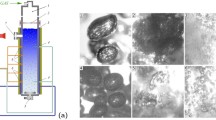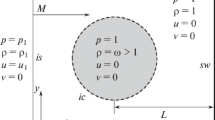Abstract
The processes of breaking, solution, and formation of hydrates behind a shock wave of moderate amplitude were studied experimentally in water with carbon dioxide bubbles under different initial static pressures. It is shown that an increase in the static pressure in a gas-liquid medium leads to reduction of critical relative amplitude of the shock wave, corresponding to starting development of Kelvin — Helmholtz instability and bubble splitting into small gas inclusions behind the shock wave front. It is shown that the rates of carbon dioxide solution and hydrate formation behind the shock wave front are close by the value; their dependences on medium and wave parameters are determined. Calculations by the model of gas hydration behind the shock wave are presented.
Similar content being viewed by others
References
Direct Ocean Disposal of Carbon Dioxide, N. Handa, T. Oshumi (Eds.), Terrapubl., Tokyo, 1995.
V. Anderson, S. Woodhouse, O.Fr. Graff, and J.S. Gudmundson, Hydrates for deep ocean storage of CO2, in: Proc. 5th Int. Conf. on Gas Hydrates, Trondheim, Norway, June 13–16, 2005, P. ref. 4006, P. 1135–1139.
S. Tanaka, F. Maruyama, O. Takano, K. Uchida, and N. Oya, Experimental study on CO2 storage and sequestration in form of hydrate pellets, in: Proc. 5th Int. Conf. on Gas Hydrates, Trondheim. Norway, June 13–16, 2005, P. ref. 4028, P. 1314–1319.
S. Tanaka, O. Takano, K. Uchida et al., Gas hydrate formation technology using low-temperature and low-pressure conditions. Pt 2. Study on application to CO2 separation with a bench plant, in: Proc. 5th Int. Conf. on Gas Hydrates, Trondheim, Norway, June 13–16, 2005, P. ref. 4031, P. 1332–1339.
M. Ota, M. Seko, and H. Endou, Gas separation process of carbon dioxide from mixed gases by hydrate production, in: Proc. 5 Int. Conf. on Gas Hydrates, Trondheim, Norway, June 13–16, 2005, P. ref. 4032, P. 1340–1343.
R. Ohmura, S. Kashiwazaki, S. Shiota et al., Structure-1 and structure-2 hydrate formation using water spraying, in: Proc. 4th Int. Conf. on Gas Hydrates, Yokohama, Japan, May 19–23, 2002, P. 1049–1054.
K. Miyata, T. Okui, H. Hirayama et al., A challenge to high-rate industrial production of methane hydrate, in: Proc. 4th Int. Conf. on Gas Hydrates, Yokohama, Japan, May 19–23, 2002, P. 1031–1035.
I.S. Gudmundsson, Method for obtaining gas hydrates for transportation and storage: Patent RF 2200727, C07C5/02, No. 97112086/06; Appl. 02.07.1997; Publ. 20.03.2003, Bull. No. 8.
V.S. Yakushev, Method of extraction and transportation of natural gas from gas and gas-hydrate sea-based deposits, called flowers and bees: Patent RF 2198285, E21B43/01, No. 98113838/03; Appl. 13.07.1998; Publ. 10.02.2003, Bull. No.4.
H. Tajima, A. Yamasaki, F. Kiyono, T. Nagata, and T. Masuyama, Continuous gas hydrate formation process by static mixing of fluids, in: 5th Int. Conf. on Gas Hydrates, Trondheim, Norway, June 13–16, 2005, P. ref. 1010, P. 75–80.
K.V. Komissarov and V.A. Finochenko, Facility for obtaining gas hydrates: Patent RF 2045718, F25D3/12, No. 5044706/13; Appl. 29.05.1992, Publ. 10.10.1995, Bull. No. 28.
Y. Kozo, F. Tetsuro, K. Takahiro, and K. Yuichi, Patent GB 2347938 A, C 07 C7/152; No. 0006039.2, Publ. 20.09.2000.
V.E. Dontsov, V.E. Nakoryakov, and L.S. Chernoy, Method of Gas Hydrate Production: Patent RF 2270053, reg. 20. 02. 2006, Priority of Invention of 11.11.2003.
V.E. Dontsov, V.E. Nakoryakov, and A.A. Chernov, Formation of gas hydrates in a gas-liquid mixture behind a shock wave, Doklady Physics, 2006, Vol. 51, No. 2, P. 190–193.
V.K. Kedrinsky and R.I. Soloukhin, Compression of a spherical gas cavity by a shock wave in water, J. Appl. Mech. and Tech. Phys., 1961, No. 1, P. 27–29.
B.E. Gelfand, S.A. Gubin, S.M. Kogarko, S.M. Simakov, and E.V. Timofeev, Studying gas bubble breaking by shock waves in liquid, Fluid Dynamics, 1975, No. 4, P. 51–56.
V.E. Nakoryakov, B.G. Pokusaev, and I.R. Shreiber, Wave Propagation in Gas Liquid Media, CRC Press, Boca Raton, 1993.
Yu.F. Makogon, Gas Hydrates, Prevention of Their Formation, and Application, Nedra, Moscow, 1985.
Yu.F. Makogon, Hydrates of Hydrocarbons, Tulsa, Oklahoma, Pennwell Publ. Comp., 1997.
V.E. Dontsov and V.E. Nakoryakov, Enhancement of shock waves in a porous medium saturated with liquid having soluble-gas bubbles, Int. J. Multiphase Flow, 2001, Vol. 27, No. 12, P. 2023–2041.
Author information
Authors and Affiliations
Additional information
The work was financially supported by the Russian Foundation for Basic Research (grants Nos. 06-01-00142 and 06-08-00657).
Rights and permissions
About this article
Cite this article
Dontsov, V.E., Chernov, A.A. & Dontsov, E.V. Shock waves and formation of carbon dioxide hydrate at an increased pressure in the gas-liquid medium. Thermophys. Aeromech. 14, 21–35 (2007). https://doi.org/10.1134/S0869864307010040
Received:
Issue Date:
DOI: https://doi.org/10.1134/S0869864307010040




